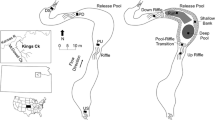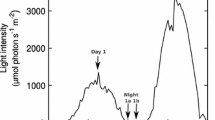Abstract
We assessed diel animal habitat use in three shallow ponds, using unbaited funnel traps, a large column sampler, and sweep net collections in the upper stratum (0–0.3 m) of littoral and open habitats. In all three ponds, more animals were caught at night than during the day, indicating that use of near-surface waters was greatest at night, particularly in the fishless ponds. All methods yielded similar patterns. Our results demonstrate that nocturnal observations of pond animals are necessary to describe their ecology, even in fishless ponds where diel differences in habitat use or behavior might not be anticipated.
Similar content being viewed by others
References
Aiken, R. B. & R. E. Roughley, 1985. An effective trapping and marking method for aquatic beetles. Proc. Acad. nat. Sci. Philad. 137: 5–7.
Allison, E. H., K. Irvine, A. B. Thompson & B. P. Ngatunga, 1996. Diets and food consumption rates of pelagic fish in Lake Malawi, Africa. Freshwat. Biol. 35: 489–515.
Birch, M. W., 1963. An algorithm for the logarithmic series distribution. Biometrics 19: 651–652.
Bohl, E., 1980. Diel pattern of pelagic distribution and feeding in planktivorous fish. Oecologia 44: 368–375.
Brittain, J. E. & T. J. Eikeland, 1988. Invertebrate drift-a review. Hydrobiologia 166: 77–93.
Caley, M. J. & J. St. John, 1996. Refuge availability structures assemblages of tropical reef fishes. J. anim. Ecol. 65: 414–428.
Cook, E. F., 1956. The Nearctic Chaoborinae (Diptera: Culicidae). University of Minnesota Agricultural Experiment Station Technical Bulletin 218: 1–102.
Cowan, C. A. & B. L. Peckarsky, 1994. Diel feeding and positioning periodicity of a grazing mayfly in a trout stream and a fishless stream. Can. J. Fish. aquat. Sci. 51: 450–459.
Cox, R. R. Jr., M. A. Hanson, C. C. Roy, N. H. Euliss Jr., D. H. Johnson & M. G. Butler, 1998. Mallard duckling growth and survival in relation to aquatic invertebrates. J. Wildlife Manage. 62(1): 124–133.
Dean, R. L. & J. H. Connell, 1987a. Marine invertebrates in an algal succession. II. Tests of hypotheses to explain changes in diversity with succession. J. exp. mar. Biol. Ecol. 109: 217–247.
Dean, R. L. & J. H. Connell, 1987b. Marine invertebrates in an algal succession. III. Mechanisms linking habitat complexity with diversity. J. exp. mar. Biol. Ecol. 109: 217–247.
Dini, M. L. & S. R. Carpenter, 1992. Fish predators, food availability and diel vertical migration in Daphnia. J. Plankton Res. 14(3): 359–377.
Fisher, R. A., A. S. Corbet & C. B. Williams, 1943. The relation between the number of species and the number of individuals in a random sample of an animal population. J. anim. Ecol. 12: 42–58.
Flecker, A. S., 1992. Fish predation and the evolution of invertebrate drift periodicity: evidence from neotropical streams. Ecology 73(2): 438–448.
Gilbert, J. J., C. W. Burns & C. C. Gilbert, 1999. Summer distribution patterns of the backswimmer, Anisops wakefieldi (Hemiptera: Notonectidae), in a New Zealand pond. New Zealand J. mar. Freshwat. Res. 33: 661–672.
Hall, D. J., E. E. Werner, J. F. Gilliam, G. G. Mittelbach, D. Howard & C. G. Doner, 1979. Diel foraging behavior and prey selection in the Golden Shiner (Notemigonus crysoleucas). J. Fish. Res. Bd Can. 36: 1029–1039.
Haney, J. F., 1988. Diel patterns of zooplankton behavior. Bull. mar. Sci. 43(3): 583–603.
Hilsenhoff, W. L., 1987. Effectiveness of bottle traps for collecting Dytiscidae (Coleoptera). The Coleopterists Bulletin 41(4): 377–380.
Holomuzki, J. R. & J. D. Hoyle, 2000. Effect of predatory fish presence and habitat use and diel movement of the stream amphipod, Gammarus minus. Freshwat. Biol. 24: 509–517.
Hungerford, H. B., 1933. The genus Notonecta of the world (Notonectidae-Hemiptera). University of Kansas Science Bulletin 21: 5–195.
James, M. R., M. Weatherhead, C. Stangor & E. Graynoth, 1998. Macroinvertebrate distribution in the littoral zone of Lake Coleridge, South Island, New Zealand-effects of habitat stability, wind exposure, and macrophytes. New Zealand J. mar. Freshwat. Res. 32: 287–305.
Johnson, J. H., 1995. Diel feeding ecology of three species of aquatic insects. J. Freshwat. Ecol. 10(2): 183–188.
Johnson, S. L. & A. P. Covich, 2000. The importance of night-time observations for determining habitat preferences of stream biota. Regulated Rivers: Research and Management 16: 91–99.
Lampert, W. & B. E. Taylor, 1985. Zooplankton grazing in a eutrophic lake: implications of diel vertical migration. Ecology 66(1): 68–82.
Levy, D. A., 1990. Reciprocal diel vertical migration behavior in planktivores and zooplankton in British Colombia lakes. Can. J. Fish. aquat. Sci. 47: 1755–1764.
Marchant, R., 1982. Seasonal variation in the macroinvertebrate fauna of billabongs along Magela Creek, Northern Territory. Aust. J. mar. Freshwat. Res. 33: 329–342.
Martin-Smith, K. M., 1993. Abundance of mobile epifauna: the role of habitat complexity and predation by fishes. J. exp. mar. Biol. Ecol. 174: 243–260.
Merritt, R. W. & K. W. Cummins, 1984. An Introduction to the Aquatic Insects of North America. Kendall/Hunt Publishing Co. Dubuque, IA: 722 pp.
Neill, W. E., 1990. Induced vertical migration in copepods as a defence against invertebrate predation. Nature 345: 524–526.
O'Connor, N. A., 1991. The effects of habitat complexity on the macroinvertebrates colonising wood substrates in a lowland stream. Oecologia 85: 504–512.
Ó Hare, M. T. & K. J. Murphy, 1999. Invertebrate hydraulic microhabitat and community structure in Callitriche stagnalis Scop. patches. Hydrobiologia 415: 169–176.
Peckarsky, B. L., P. R. Fraissinet, M. A. Penton & D. J. Conklin Jr., 1990. Freshwater Macroinvertebrates of Northeastern North America. Cornell University Press, Ithaca, New York: 442 pp.
Peckarsky, B. L., 1996. Alternative predator avoidance syndromes of stream-dwelling mayfly larvae. Ecology 77(6): 1888–1905.
Pennak, R.W., 1944. Diurnal movements of zooplankton organisms in some Colorado mountain lakes. Ecology 25(4): 387–403.
Pierce, C. L., 1988. Predator avoidance, microhabitat shift, and risksensitive foraging in larval dragonflies. Oecologia 77: 81–90.
Piet, G. J. & W. A. H. P. Guruge, 1997. Diel variation in feeding and vertical distribution of ten co-occurring fish species: consequences for resource partitioning. Envir. Biol. Fishes 50: 293–307.
Resh, V. H. & D. M. Rosenberg, 1989. Spatial-temporal variability and the study of aquatic insects. The Canadian Entomologist 121: 941–963.
Streams, F. A., 1992. Age-dependent foraging depths of two species of Notonecta (Heteroptera: Notonectidae) breeding together in a small pond. Aquatic Insects 14(3): 183–191.
Streams, F. A. & T. P. Shubeck, 1982. Spatial structure and intraspecific interactions in Notonecta populations. Envir. Ent. 11(3): 652–659.
Teragushi, M. & T. G. Northcote, 1966. Vertical distribution and migration of Chaoborus flavicans larvae in Corbett Lake, British Columbia. Limnol. Oceanogr. 11(2): 164–176.
Tokeshi, M., 1993. Species abundance patterns and community structure. Adv. ecol. Res. 24: 111–186.
Truxal, F. S., 1953. A revision of the genus Buenoa (Hemiptera Notonectidae). University of Kansas Science Bulletin 35: 1351–1521.
Van Buskirk, J., 1992. Competition, cannibalism, and size class dominance in a dragonfly. Oikos 65: 455–464.
Voss, S. & H. Mumm, 1999. Where to stay by night and day: Size-specific and seasonal differences in horizontal and vertical distribution of Chaoborus flavicans larvae. Freshwat. Biol. 42: 201–213.
Waters, T. F., 1962. Diurnal periodicity in the drift of stream invertebrates. Ecology 43(2): 316–320.
Wood, K. G., 1956. Ecology of Chaoborus (Diptera: Culicidae) in an Ontario lake. Ecology 37(4): 639–643.
Zaret, T. M. & J. S. Suffern, 1976. Vertical migration in zooplankton as a predator avoidance mechanism. Limnol. Oceanogr. 21: 804–813.
Author information
Authors and Affiliations
Rights and permissions
About this article
Cite this article
Hampton, S.E., Friedenberg, N.A. Nocturnal increases in the use of near-surface water by pond animals. Hydrobiologia 477, 171–179 (2002). https://doi.org/10.1023/A:1021059108674
Issue Date:
DOI: https://doi.org/10.1023/A:1021059108674




